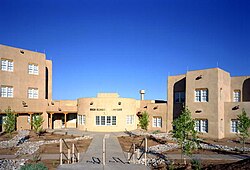Santa Fe Indian School
| Santa Fe Indian School | |
|---|---|
 |
|
 |
|
| Address | |
|
1501 Cerrillos Road P.O. Box 5340 Santa Fe, New Mexico 87501 United States |
|
| Information | |
| School type | Boarding School |
| Established | 1890 |
| School board | Northern Pueblos Education Line Office |
| Superintendent | Roy Herrera |
| Grades | 7–12 |
| Enrollment | 709 (2005–2006) |
| Color(s) | Maroon & Gold |
| Athletics conference |
NMAA AAA District 2 |
| Team name | Braves |
| Website | http://www.sfis.k12.nm.us/ |
The Federal Government established the Santa Fe Indian School (SFIS) in 1890 to educate Native American children from tribes throughout the Southwestern United States. The purpose of creating SFIS was an attempt to assimilate the Native American children into the wider United States culture and economy. In 1975, the All Indian Pueblo Council (AIPC) was formed. It was the first Indian organization to utilize the laws in place to contract an education for their children. Eventually, the AIPC was able to leverage complete control of the school and curriculum. In 2001, with the passing of the SFIS Act, the school took ownership of the land. The school resides on the form of a trust, which is held by the nineteen Pueblo Governors of New Mexico. These acts allow for complete educational sovereignty of the school, by the Pueblo.
The original concept of the Indian Boarding School began as a social experiment predating the Civil War. Around the 1860s, the United States Federal Government created “day schools” to educate children about Western Civilization. They were ineffective in this process because the students did not retain the knowledge acquired at school. A factor in knowledge retention was the students returning home. After discovering this method of education was ineffective, a different approach was taken. In the 1870s, the concept of Indian Boarding Schools came into fruition. Army Lt. Richard Henry Pratt captured seventy-two Native American prisoners who fought against the Army; he tested his version of the social experiment that was previously attempted on the children. Pratt desired to mold the “savages” into “civilized” people. Pratt taught the Native American prisoners how to speak English and educated the Native Americans on European society and religion. After this educational experience, sixty-two of the Natives went to the Hampton Institute in Virginia. Deciding to extend the experiment further, Pratt was able to convince Native American families to allow their children to attend his boarding school. Richard H. Pratt founded the Carlisle Indian Industrial School in 1879; the difference being, unlike day schools, Carlisle was located over thousand miles away from the reservation. The Carlisle Indian Industrial School was the first boarding school specifically for Native Americans. The reasoning behind positioning the school a great distance from the reservations was that Pratt believed distance would help break the ties to Native American culture. He has been quoted as saying, “In Indian civilization I am a Baptist, because I believe in immersing the Indian in our civilization and when we get them under, holding them there until they are thoroughly soaked.”. Pratt desired to remove the children from their Native roots, and he was harsh in the actions he took. Being that Pratt was from the Armed Forces, his background dictated how he operated the school. The students were forced to cut their hair, a symbol of their pride. One boarding school student was quoted as saying, "[Long hair] was the pride of all Indians. The boys, one by one, would break down and cry when they saw their braids thrown on the floor. All of the buckskin clothes had to go and we had to put on the clothes of the White Man”. The students were stripped of all traces of what their culture was, such as: their long hair, their clothing, and their native language. The same student went on to say, “This is when the loneliness set in, for it was when we knew that we were all alone. Many boys ran away from the school because the treatment was so bad, but most of them were caught and brought back by the police”. Having to deal with the oppression of the school and lack of contact from their families, the students were struck with a feeling of loneliness.
...
Wikipedia
